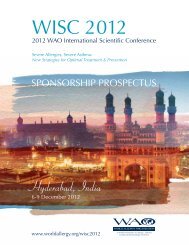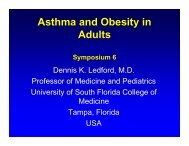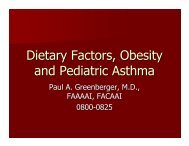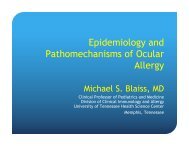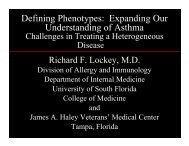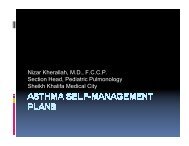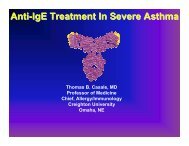Dubai Final-v20.indd - World Allergy Organization
Dubai Final-v20.indd - World Allergy Organization
Dubai Final-v20.indd - World Allergy Organization
Create successful ePaper yourself
Turn your PDF publications into a flip-book with our unique Google optimized e-Paper software.
ABstrACts<br />
ABstrACts<br />
were significantly associated with eosinophilic infiltration rather than metastasis. Causes of eosinophilic infiltration were parasite<br />
infection (n=15), drug (n=1) and undetermined (n=14).<br />
Conclusion: Our results suggest that eosinophilic organ infiltration has distinguished clinical characteristics compared with<br />
cancer metastasis. moreover, physicians need to have more efforts to find the causes of organ involvement with peripheral blood<br />
eosinophilia, especially in cancer patients.<br />
2103<br />
oPPoSiTE EFFECT oF ETanErCEPT anD inFliXimaB on THE DEVEloPmEnT oF CUTanEoUS VaSCUliTiS<br />
Kim, J.<br />
Pediatrics, seoul national University College of medicine and rheumatology research institute, snU Hospital, seoul, south Korea.<br />
We report here a case that showed opposite effect of two tnF-α antagonists, etanercept and infliximab, on cutaneous vasculitis<br />
in a patient with JrA. three tnF-α antagonists, etanercept, infliximab, and adalimunmab are now available for the treatment of<br />
JrA in Korea. As JrA is a chronic condition, increase of adverse effects by long-term use is a major obstacle in tnF-α antagonists<br />
therapy. these include injection-site reaction, infusion-related reactions, infections, lymphoma, and lupus-like symptoms.<br />
recently, development of cutaneous vasculitis has been observed in patients receiving tnF-α antagonists. We experienced<br />
a JrA patient treated with etanercept(25~50mg/week) for 2 1/2 years developed cutaneous vasculitis on both of lower legs.<br />
Pathological examination of skin biopsy revealed leukocytoclastic vasculitis. thus, etanercept therapy was discontinued due to<br />
the extent and severity of vasculitis. After cessation of treatment for 4 months, the patient’s disease activity developed again and<br />
infliximab(100mg/8weeks) was administered with remission of disease activity. Unexpectedly, however, we found that cutaneous<br />
vasculitis was improved effectively by infliximab. this observation indicates that cutaneous vasculitis developed after introduction of<br />
one tnF-α antagonist(etanercept) can be improved with administration of another tnF-α antagonist(infliximab) and suggests that<br />
the opposite effect of these agents is probably associated with their ability to bind to tnF- α.<br />
2104<br />
BronCHoalVEolar laVagE anD SErUm EoSinoPHil CaTioniC ProTEin lEVElS in CHroniC aSTHma anD BronCHial<br />
CarSinoma<br />
Kose, s. 1 , Arici, m. 2 , Cavdar, g. 1 , Yavas, s. 1 and Camci, g. 1<br />
1infectious Diseases and Clinical microbiology, Clinical <strong>Allergy</strong> and immunology, tepecik Educational and research Hospital, izmir,<br />
turkey. 2Pulmonery Diseases, tepecik Educational and research Hospital, izmir, turkey.<br />
inTroDUCTion<br />
immunoglobuline E (igE) and eosinophil cationic protein (ECP) are important markers for atopy and allergic inflamation. Elevated<br />
ECP levels may be found in the serum as well as the bronchoalveolar and nasopharyngeal secretions in many diseases, including<br />
asthma, bronchiolitis and infections.<br />
mETHoDS<br />
the ECP in bronchoalveolar lavage fluid and in serum was measured in 15 patients with chronic pulmonary diseases such as<br />
bronchial carsinoma (7 of patients) and asthma (8 of patients).<br />
rESUlTS<br />
ECP levels in BAl fluids were higher in the patients with asthma (mean ECP level : 1,75 mcg/l) than in the bronchial carsinoma<br />
group (mean ECP level : 4 mcg/l). serum ECP levels ; were found 8,5 mcg/l in asthmatic group, and 3,4 mcg/l in patients with<br />
bronchial carcinoma.<br />
DiSCUSSion<br />
in conclusion we can say that serum and BAl ECP levels are useful markers for predicting eosinophilic airways inflamation, and<br />
serum ECP concentrations may be helpful noninvasive markers of atopic asthma.<br />
2105<br />
SUlFaTED moDiFiCaTion oF lYCiUm BarBarUm PolYSaCCHariDE UnDEr miCroWaVE irraDiaTion anD THEir anTi-HiV<br />
aCTiViTiES<br />
Zhu, X. and Zhang, H.<br />
Beijing University of technology, Beijing, China.<br />
the sulfated Lycium barbarum polysaccharide (lBP) were prepared by chlorosulfonic acid–pyridine (Py-sO ) method according to<br />
3<br />
orthogonal l (3) 9 4 test under microwave irradiation. Eight sulfated slBP, with various degrees of sulfate (Ds) and the number average<br />
molecular weight (M ), were obtained and their anti-HiV activities were compared by mtt and ElisA assay. the results indicated<br />
w<br />
www.worldallergy.org 120<br />
FinAl PrOgrAm



